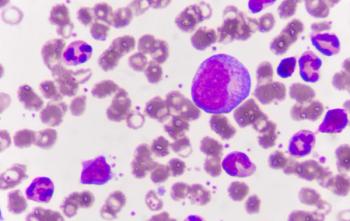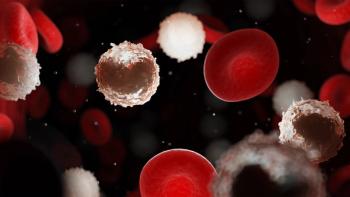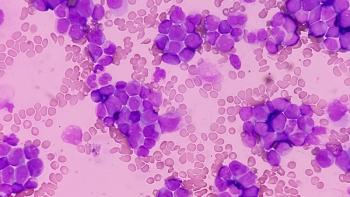
Venetoclax Has Impressive Activity in ER+ and BCL-2+ Breast Cancer
Combining the BCL-2 inhibitor venetoclax (Venclexta) with endocrine therapy elicited notable activity with a tolerable safety profile in patients with estrogen receptor (ER)–positive and BCL-2–positive metastatic breast cancer.
Combining the BCL-2 inhibitor venetoclax (Venclexta) with endocrine therapy elicited notable activity with a tolerable safety profile in patients with estrogen receptor (ER)—positive and BCL-2–positive metastatic breast cancer.
Geoffrey J. Lindeman, MD, presented data from a phase Ib dose-escalation and expansion study, the first clinical study evaluating venetoclax in a solid tumor, at the 2018 San Antonio Breast Cancer Symposium.
Among 33 evaluable patients who received the combination of venetoclax and tamoxifen, the median progression-free survival (PFS) was 36 weeks in 15 patients treated in the dose escalation phase, 48 weeks in 18 patients treated in the expansion phase, and 36 weeks overall. Median PFS was 23 weeks in those who received doses of venetoclax <800 mg versus 51 weeks in those who received 800 mg of venetoclax, the maximum dose in the study.
The overall response rate (ORR) was 27% and the clinical benefit rate (CBR) was 67% in the dose escalation phase. No patient had a complete response (CR), and the median duration of response (DOR) was 61 weeks.
In the dose expansion phase, the ORR was 61% and the clinical benefit rate was 72%, with 1 CR. The median DOR was 39 weeks.
In the 24 patients who received 800 mg of venetoclax, the ORR was 54% and the CBR was 75%, with 1 CR (4%) and 12 partial responses (50%). The median DOR was 42 weeks. Eight patients from the 800-mg cohort remain on study treatment; the DOR reported here is until the cutoff date.
“In the primary setting, about 80% of ER-positive tumors prove to be BCL-2—positive,” said Lindeman, from the Walter and Eliza Hall Institute of Medical Research in Melbourne, Australia. “What we found from this study is that about 70% of tumors remain BCL-2–positive in patients who undergo a biopsy of their metastases.”
In preclinical models of ER-positive breast cancer, venetoclax synergized with endocrine therapy.
The 3+3 dose escalation study included 15 patients who received daily venetoclax at 200 mg (n = 3), 400 mg (n = 3), 600 (n = 3), or 800 mg (n = 6) along with 20 mg of daily tamoxifen. Treatment continued until progression.
The primary endpoint was to determine the maximum tolerated dose, define dose-limiting toxicities, and identify the recommended phase II dose. In the dose-expansion phase at the recommended phase 2 dose, secondary endpoints including safety and tolerability, response at 24 weeks per RECIST v1.1, the clinical benefit rate, and PFS.
Overall, 88% of patients were strongly ER-positive and 85% were strongly BCL-2—positive. Some 79% of patients had bone metastases and 61% had visceral metastases. The mean number of prior regimens was 2 (range, 0-8), with 45% having <2 prior lines. Thirty-nine percent had prior tamoxifen exposure in the adjuvant setting, 12% in the metastatic setting only, and 36% had no prior tamoxifen exposure. Twenty-seven percent of patients had prior chemotherapy in the adjuvant setting only and 15% in the metastatic setting only; 36% did not receive prior chemotherapy.
“In our dose escalation study, we went beyond the recommended phase II dose for chronic lymphocytic leukemia, which is 400 mg/day. We got to 800 mg/day without getting to a maximum tolerated dose, so we elected to us the recommended phase 2 dose of 800 mg/day. The reason we didn’t go higher is simply that the pill burden would be too high [8 tablets a day],” said Lindeman.
Patients who achieved a metabolic response on FDG-positron emission tomography at 28 days had a significantly longer PFS than those with metabolic progression or stable metabolic disease (P = .004).
“It’s hard to know with a study of this size, but we seemed to be achieving clinical responses at the 400- to 800-mg doses, but we have more experience now with the 800-mg dose,” he said. “It certainly would be predicted to give higher levels of BCL-2 in the blood, probably about double the levels of BCL-2 in the blood than the 400-mg dose.”
No patient had to discontinue on the basis of toxicity. The main side effects with venetoclax were on-target effects, including grade 1-3 lymphopenia, “which didn’t cause any other adverse events of infections to our knowledge,” Lindeman said.
Lymphopenia occurred in 100% at venetoclax doses <800 mg and in 83% at the 800-mg dose. Neutropenia occurred in 56% at doses <800 mg and in 79% in those dosed at 800 mg. Thirty-eight percent had an infection at the 800-mg dose compared with none at lower doses.
“The other side effect we see is low-grade nausea, which occurs a couple of hours after taking the tablets and is often ameliorated by giving antiemetic tablets like metoclopramide,” he said. “Otherwise, we saw very few side effects with venetoclax in this small phase Ib study.”
Sixty-seven percent of patients experienced nausea at the <800-mg dose.
Lindeman said that investigators have already initiated a phase II trial called VERONICA. BCL-2-positive patients who have progressed on a CDK4/6 inhibitor will be randomly assigned to fulvestrant with or without 800 mg of venetoclax.
Reference
Lindeman GJ, Lok SW, Whittle JR, et al. A phase 1b dose-escalation and expansion study of the BCL-2 inhibitor venetoclax combined with tamoxifen in ER and BCL-2—positive metastatic breast cancer (MBC). Presented at: Presented at: 2018 San Antonio Breast Cancer Symposium; December 4-8, 2018; San Antonio, Texas. Abstract PD1-06.
This article was originally published on
Newsletter
Knowledge is power. Don’t miss the most recent breakthroughs in cancer care.
















































































